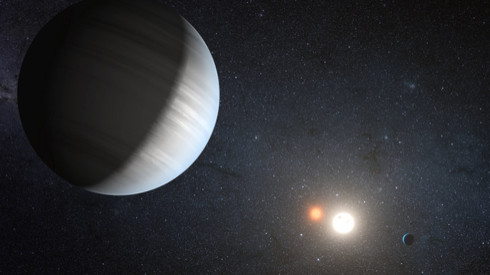Two Suns Could Increase The Possibility Of Life On Other Planets

Researchers are suggesting two suns may be better than one. If the theory is correct, it would vastly increase the number of planets that could, potentially, sustain life and give astronomers new targets to observe.
Astronomers from the University of Texas at El Paso, ot UTEP, and New Mexico State University have found a mechanism that exists only between binary stars that may increase the chance a planet could sustain liquid water at its surface. The researchers also point out the fact that the mechanism could actually make it more difficult to sustain liquid water on planet orbiting a binary system. The research, led by Paul A. Mason from UTEP, will be published in Astrophysical Journal Letters. The astronomers belong to Group of Computational Physics and Astrophysics, FACom.
The mechanism is based on the two stars orbiting one another in a binary system becoming tidally locked. The moon is tidally locked to the Earth and one side of the moon always facing the Earth. Tidal locking occurs when a body’s rotation synchronizes to its orbit of the larger host, due to the effects of gravity. In the case of the moon, it takes 27 days to complete one revolution -- the same amount of time needed to complete one orbit around the Earth.
While tidal locking is a bad thing for planets -- half of the planet would receive all the light while the other half would be freezing -- it may be beneficial to a binary star system. A young star is incredibly hot, which could prevent the formation of an atmosphere on a planet orbiting it, which would eliminate any possibility of water, or life, being sustained on the planet. Over time, the rotation of a star slows down and it cools down. The sun is around 4.5 billion years old, and, while still incredibly hot, it is not as hot as it once was. The astronomers believe the incredibly hot sun during its youth may have prevented any chance of Venus or Mercury sustaining liquid water on their respective surfaces.
Tidal locking between two stars in a binary could prematurely reduce the rotation of young star, thereby making it cooler. The stars would have to be tidally locked from the beginning of their formation, notes the researchers, and these young stars could act more like a middle-age star. This mechanism, called “rotational aging,” could reduce the radiation a planet receives from the binary stars, increasing the chance for an atmosphere to form and the development of liquid water on the planet’s surface.
Currently, the search for planets that could sustain liquid water on its surface, and therefore life, is limited to planets within its host star’s habitable zone. In that location, the temperature is neither too hot nor too cold for liquid water, and, because the temperature has to be just right to main liquid water, astronomers have dubbed this area the Goldilocks zone.
The researchers identified three candidate systems, Kepler 34, Kepler 47 and Kepler 64, that have planets orbiting the binary stars that are tidally locked. It is possible that, based on the rotational aging mechanism, Kepler 34 could have more than one planet in its habitable zone. There is a possibility that tidally locked stars could be synchronized to rotate faster, increasing their heat well into middle-age. The astronomers hope to test this mechanism on the candidate systems.
© Copyright IBTimes 2024. All rights reserved.






















